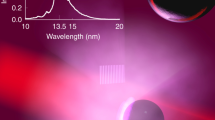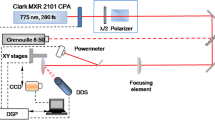Abstract
Extreme ultraviolet (EUV) lithography produces 13.5 nm light by irradiating a droplet of molten Sn with a laser, creating a dense, hot laser-produced plasma and ionizing the Sn to the + 8 through + 12 states. An unwanted by-product is deposition of Sn debris on the collector optic, which focuses the EUV light emitting from the plasma. Consequently, collector reflectivity is degraded. Reflectivity restoration can be accomplished by means of Sn etching by hydrogen radicals, which can be produced by an H2 plasma and etch the Sn as SnH4. It has previously been shown that plasma cleaning can successfully create radicals and restore EUV reflectivity but that the Sn removal rate is not necessarily limited by the radical density. Additionally, while Sn etching by hydrogen radicals has been shown by multiple investigators, quantification of the mechanisms behind Sn removal has never been undertaken. This paper explores the processes behind Sn removal. Experiments and modeling show that, within the parameter space explored, the limiting factor in Sn etching is not radical flux or SnH4 decomposition, but ion energy flux. Thus the removal is akin to reactive ion etching.
















Similar content being viewed by others
Change history
03 April 2018
The original version of this article unfortunately contained a mistake in the “Deposition of Stannane (DOS) Chamber” section.
References
Moore GE (1998) Cramming more components onto integrated circuits. Proc IEEE 86(1):82–85
Shilov A (2017) Samsung and TSMC roadmaps: 8 and 6 nm added, looking at 22ULP and 12FFC, Anandtech.com. http://www.anandtech.com/show/11337/samsung-and-tsmc-roadmaps-12-nm-8-nm-and-6-nm-added. Accessed 24 May 2017
Benschop J (2009) EUV: past, present and prospects Jos Benschop. Int Symp Extreme Ultrav Lithogr
Burdt RA et al (2010) Laser wavelength effects on the charge state resolved ion energy distributions from laser-produced Sn plasma. J Appl Phys 107(4):043303
Kagawa T, Tanuma H, Ohashi H, Nishihara K (2007) RCI simulation for EUV spectra from Sn ions. J Phys: Conf Ser 58:149–152
Hecquet C et al (2007) Design, conception and metrology of EUV mirrors for aggressive environments. Damage VUV EUV X-ray Opt 6586:65860X–65860X–10
Allain JP et al (2007) Energetic and thermal Sn interactions and their effect on EUVL source collector mirror lifetime at high temperatures. Proc SPIE 6517:65171V–65171V–10
Burdt RA (2011) Ion emission and expansion in laser-produced tin plasma, University of California, San Diego (Ph.D. Diss.)
van Herpen MMJW, Klunder DJW, Soer WA, Moors R, Banine V (2010) Sn etching with hydrogen radicals to clean EUV optics. Chem Phys Lett 484(4–6):197–199
Ugur D, Storm AJ, Verberk R, Brouwer JC, Sloof WG (2012) Generation and decomposition of volatile tin hydrides monitored by in situ quartz crystal microbalances. Chem Phys Lett 552:122–125
Ugur D, Storm AJ, Verberk R, Brouwer JC, Sloof WG (2014) Decomposition of SnH4 molecules on metal and metal-oxide surfaces. Appl Surf Sci 288:673–676
Braginsky OV et al (2012) Removal of amorphous C and Sn on Mo: Si multilayer mirror surface in Hydrogen plasma and afterglow. J Appl Phys 111(9):1–5
Elg DT, Sporre JR, Panici GA, Srivastava SN, Ruzic DN (2016) In situ collector cleaning and extreme ultraviolet reflectivity restoration by hydrogen plasma for extreme ultraviolet sources. J Vac Sci Technol A Vac Surf Film 34(2):21305
Elg DT, Panici GA, Peck JA, Srivastava SN, Ruzic DN (2017) Modeling and measurement of hydrogen radical densities of in situ plasma-based Sn cleaning source. J Micro/Nanolithogr MEMS MOEMS 16(2):23501
Mozetič M, Drobnič M, Pregelj A, Zupan K (1996) Determination of density of hydrogen atoms in the ground state. Vacuum 47(6):943–945
Mozetic M, Vessel A, Cvelbar U, Ricard A (2006) An iron catalytic probe for determination of the O-atom density in an Ar/O2 afterglow. Plasma Chem Plasma Process 26(2):103–117
Mozetic M, Vesel A, Drenik A, Poberaj I, Babic D (2007) Catalytic probes for measuring H distribution in remote parts of hydrogen plasma reactors. J Nucl Mater 363–365(1–3):1457–1460
Ruzic DN (1994) Electric probes for low temperature plasmas. American Vacuum Society Press, New York
Tamaru K (1956) The thermal decomposition of tin hydride. J Phys Chem 60(5):610–612
Finholt AE, Bond AC, Wilzbach KE, Schlesinger HI (1947) The preparation and some properties of hydrides of elements of the fourth group of the periodic system and of their organic derivatives. J Am Chem Soc 69(11):2692–2696
Paneth F, Haken W, Rabinowitech E (1924) Uber die Reindarstellung und EIgenschaften des Zinnwasserstoffs. Berichte der Dtsch Chem Gesellschaft 57:1891–1903
Norman AD, Webster JR, Jolly WL (1968) 36. Silane, stannane, silane44, germane449 and stannane-d4. Inorg Synth XI:170–181
Elg DT (2016) Removal of tin from extreme ultraviolet collector optics by an in situ hydrogen plasma. University of Illinois at Urbana-Champaign
Cho S, Yu J, Kang SK, Shih D-Y (2005) Oxidation study of pure tin and its alloys via electrochemical reduction analysis. J Electron Mater 34(5):635–642
Sporre J et al (2012) In-situ Sn contamination removal by hydrogen plasma. Proc SPIE 8322:83222L
Sporre JR, Elg D, Ruzic DN, Srivastava SN, Fomenkov IV, Brandt DC (2013) Collector optic in situ Sn removal using hydrogen plasma. Proc SPIE 8679:86792H
Faradzhev N, Sidorkin V (2009) Hydrogen mediated transport of Sn to Ru film surface. J Vac Sci Technol A Vac Surf Film 27(2):306
Piggott MR (1957) The reduction of oxide films by atomic hydrogen. Acta Crystallogr 10:364–368
Meng L, Yu H, Szott MM, McLain JT, Ruzic DN (2014) Downstream plasma transport and metal ionization in a high-powered pulsed-plasma magnetron. J Appl Phys 115(22):223301
Zhang P, Hu L, Meegoda JN, Gao S (2015) Micro/nano-pore network analysis of gas flow in shale matrix. Sci Rep 5(1):13501
Park SK, Economou DJ (1989) A mathematical model for a plasma-assisted downstream etching reactor. J Appl Phys 66(7):3256–3267
Park SSKS, Economou DJ (1990) Numerical simulation of a single-wafer isothermal plasma etching reactor. J Electrochem Soc 137(8):2624–2634
Lieberman MA, Lichtenberg AJ (2005) Principles of plasma discharges and materials processing, 2nd edn. Wiley, Hoboken
Raizer YP, Shneider MN, Yatsenko NA (1995) Radio-frequency capacitive disscharges. CRC Press, Boca Raton
Crijns VMC (2014) Hydrogen atom based tin cleaning. Eindhoven University of Technology, Eindhoven
Acknowledgements
This material is based upon work supported by the National Science Foundation under Grant No. 14-36081. Additionally, the authors are grateful for funding and support from Cymer, LLC, an ASML company. The authors would also like to thank undergraduate students Sean Piper, Shubhang Goswami, Luke Gasparich, Shanna Bobbins, and Andreas Giakas for their help in carrying out experiments. Parts of this research were carried out in the Frederick Seitz Materials Research Laboratory Central Facilities, University of Illinois, which is partially supported by the U.S. Department of Energy under Grants DEFG02-07ER46453 and DE-FG02-07ER46471.
Author information
Authors and Affiliations
Corresponding authors
Rights and permissions
About this article
Cite this article
Elg, D.T., Panici, G.A., Liu, S. et al. Removal of Tin from Extreme Ultraviolet Collector Optics by In-Situ Hydrogen Plasma Etching. Plasma Chem Plasma Process 38, 223–245 (2018). https://doi.org/10.1007/s11090-017-9852-4
Received:
Accepted:
Published:
Issue Date:
DOI: https://doi.org/10.1007/s11090-017-9852-4




